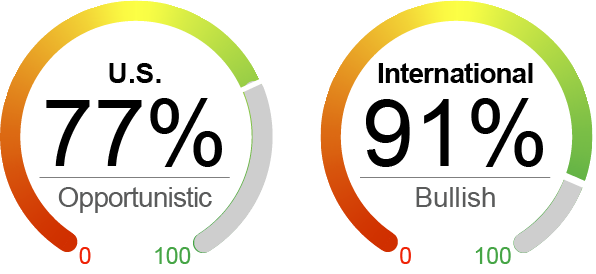Looking for Containment
Steep losses in the final week of February grabbed headlines and the attention of global investors. The lack of regional containment of the Coronavirus as well as expectations of negative economic and earnings impacts caused a precipitous decline. Investor reaction intensified last month as confirmed cases outside of China increased, specifically in South Korea, Iran and Italy. The global spread of the virus fueled fears that the economic effects will continue for some time. The most impactful of which involve concerns about consumer behavior changes, causing reduced travel and spending. We expect the real impact on earnings to be sector-specific and affected largely by reductions in economic activity in China. However, economic uncertainty did result in a broad selloff in late February, dragging all of the S&P 500’s 11 sectors negative for the year. In total, the index fell almost 13% from its record high on February 19th.
The risk of a Coronavirus pandemic is likely to continue having an effect on the economy and equity markets. The selloff in February was effective in pricing in negative expectations to some degree. It is possible that the spread has begun to plateau and the situation may improve more rapidly than anticipated. With central banks having indicated support for stimulative monetary and fiscal policies, an improvement in containment could lead to favorable economic and equity conditions.
Our models had been showing elevated valuation readings as well as neutral sentiment and macroeconomic indicators prior to the selloff. These readings pushed our cash allocation to roughly 25%, which provided some buffer during the market-wide losses. At this time, it is difficult to predict the immediate-term reaction from equity markets as it appears to be linked to containment of the virus, which is currently uncertain. Without downplaying the loss of human life, our models are currently estimating a contained situation similar to the previous recent episodes of volatility (Brexit, trade wars, and inverted yield curve) that the economy effectively powered through. For further information on our model approach during challenging market conditions, please refer to the NorthCoast Cash Scaling Strategy Fact Sheet.
By the Numbers*
U.S. Equities (S&P 500 Index) | -8.4%
International Equities (MSCI ACWI ex-U.S.) | -10.4%
U.S. Bonds (Barclays U.S. Aggregate Bond Index) | 3.8%
Global Bonds (JP Morgan Global Aggregate Bond Index) | 2.0%

The NorthCoast Navigator is a market barometer displaying NorthCoast's current U.S. equity outlook. This aggregate metric is determined by multiple data points across four broad market-moving dimensions: Technical, Sentiment, Macroeconomic, and Valuation. The daily result determines equity exposure in our tactical strategies.
As of 2/29/2020. Data provided by Bloomberg, NorthCoast Asset Management.
*Source: Bloomberg, NorthCoast Asset Management.
|
Neutral Indicators |
|
|
Positive Indicators |
|
Valuation Valuation indicators strengthened as the market sold off. S&P 500 forward P/E ratio decreased to 17.1 from 18.5. Surprisingly, the correction did not affect higher-multiple equities more severely. |
Sentiment Consumer sentiment in the U.S. remained strong last month. The University of Michigan Consumer Sentiment Survey increased to above 100. Investors and manufacturers are showing signs of worry, but there is too much uncertainty to validate these worries. |
Macroeconomic There is no quantifiable change in macroeconomic data. Growth forecasts have been revised down, but it will take time for the real figures to digest any impact of the virus. |
Technical Technical indicators did soften slightly last month. The S&P 500 fell below its moving averages and momentum stalled. However, reversal indicators strengthened due to the pullback. The VIX elevated to roughly 40. |
Important Disclosures
The information contained herein has been prepared by NorthCoast Asset Management LLC (“NorthCoast”) on the basis of publicly available information, internally developed data and other third party sources believed to be reliable. NorthCoast has not sought to independently verify information obtained from public and third party sources and makes no representations or warranties as to accuracy, completeness or reliability of such information. All opinions and views constitute judgments as of the date of writing without regard to the date on which the reader may receive or access the information, and are subject to change at any time without notice and with no obligation to update. This material is for informational and illustrative purposes only and is intended solely for the information of those to whom it is distributed by NorthCoast. No part of this material may be reproduced or retransmitted in any manner without the prior written permission of NorthCoast. NorthCoast does not represent, warrant or guarantee that this information is suitable for any investment purpose and it should not be used as a basis for investment decisions. © 2020 NorthCoast Asset Management LLC.
PAST PERFORMANCE DOES NOT GUARANTEE OR INDICATE FUTURE RESULTS.
This material should not be viewed as a current or past recommendation or a solicitation of an offer to buy or sell any securities or investment products or to adopt any investment strategy. The reader should not assume that any investments in companies, securities, sectors, strategies and/or markets identified or described herein were or will be profitable and no representation is made that any investor will or is likely to achieve results comparable to those shown or will make any profit or will be able to avoid incurring substantial losses. Performance differences for certain investors may occur due to various factors, including timing of investment. Investment return will fluctuate and may be volatile, especially over short time horizons.
INVESTING ENTAILS RISKS, INCLUDING POSSIBLE LOSS OF SOME OR ALL OF AN INVESTMENT.
The investment views and market opinions/analyses expressed herein may not reflect those of NorthCoast as a whole and different views may be expressed based on different investment styles, objectives, views or philosophies. To the extent that these materials contain statements about the future, such statements are forward looking and subject to a number of risks and uncertainties.
